|
OLD PLYMOUTH
. UK |
||
|
© Brian
Moseley, Plymouth Webpage created: July 28, 2019 Webpage updated: July 29, 2019 |
||
|
TRAMWAY SERVICES IN OLD PLYMOUTH MARKET PLACE to COMPTON LANE END via TAVISTOCK PLACE When Plymouth Corporation acquired the tramway network from the Plymouth Tramway Company in 1892 one of the two lines ran from the Market Place northwards to Compton Lane End, a point known to later generations as Hender's Corner.
Trace horses help to haul
a Plymouth Corporation tram up Tavistock Road A leader horse was put on just after turning into Old Town Street and taken off at the junction with North Road. The journey thus far took four minutes. The Hyde Park Hotel was reached in 10-minutes, where another leader horse was attached for the haul up Townsend Hill. It took 13-minutes to get to Compton Lane. The horses took the hills at a jog-trot but it was expected that when the trams were full an extra two horses would have to be added before the inclines. Other tramcars (presumable empty) were passed coming in the opposite direction at Drake's Place, Mutley Plain and on the Mannamead level. Upon arrival at Compton Depot Mr Everson conducted the guests around the stables, harness-room and the machinery for preparing the fodder. Commencement (see note A below) On Easter Monday (April 3rd) the service started at 9am and continued at 10-minute intervals until the last car left the Market Place for Compton Depot at 11pm. All day the trams were crowded, the newspaper said: 'many people seeming to ride for the novelty of the thing'. The service proper started on Tuesday April 4th 1893, being a normal working day, when the first car left at 7.45am followed by others at 8.20, 8.50 and 9am, when the 10-minute intervals started. The fare was one penny for any distance. There were no tramcars on a Sunday. Original Route (see note B below)
Subsequent development (see note C below) Once Plymouth Corporation had taken over the tramway system it set about doubling the track. From Sherwell Congregational Chapel to the foot of Townsend Hill was in the process of being doubled in January 1894 and was complete along Mutley Plain by August that year. In October 1894 the timetable for the service from the Market to Compton started with a single car leaving Compton at 7.45am and returning from the Market at 8am. This did another return working at 8.25 and 8.40am. A second car started from Compton at 8.50am and from then until 11.30am there was a 10-minute service. From 11.30am at Compton and 11.43am at the Market trams ran every 8 minutes until 1pm and then every 6 minutes until the last car at 10.40am from Compton and 11pm from the Market. There was a major change in the livery of the tramcars during 1897. On April 23rd the Council resolved to repaint the tramcars according to the route they were allocated to. Cars going to Compton would be green. This would be carried out when the cars needed renovating but it is not clear if this decision was actually carried out. An interesting diversion was a Council decision dated September 19th 1898: 'That a notice be exhibited on the tramcars requesting passengers to destroy their tickets upon leaving the car'. Electrification Wednesday April 3rd 1901 started as a normal day, with the horse trams running as usual. But at 11.30am the route to Compton Lane End was closed down. The route had been electrified from the junction with the Prince Rock route at Ebrington Street to Compton Lane End at a cost of about £18,000.During the speeches many interesting statistics were made public. One indicated that the system of running the horse-cars had been for 5 cars to run from Theatre to Hyde Park Corner (known as ‘the Mutley cars’) and for the remaining 5 cars to run from the Market to Mannamead (‘the Mannamead cars’). In future the cars would run through from the Theatre to Compton Lane End 'with a slight modification of fares, which includes the introduction of a half-penny fare from the Theatre to Ebrington-street'. Note A: Wherever possible an exact date of commencement of a service is shown. However, in a lot of cases no precise date has been recorded so reference will be made to official returns to the Council or other documentary evidence to narrow the date down as much as possible. Note B: This gives the roads and streets the service passed through. A road or street name in brackets indicates that kit has not been confirmed beyond doubt that the road or street was used by buses on this route but it is a "best guess" based on the author's knowledge of the practice at the time. If it is subsequently confirmed by either documentary or photographic evidence that the road or street was traversed by this service then the brackets will be deleted. Note C: Where deviations to the original route are shown they will be from and to a road or street named in the "Original Route" section so that the alteration in route can be easily followed.
|
||
